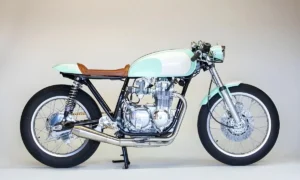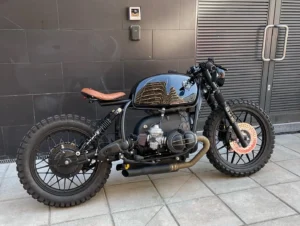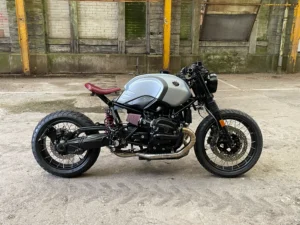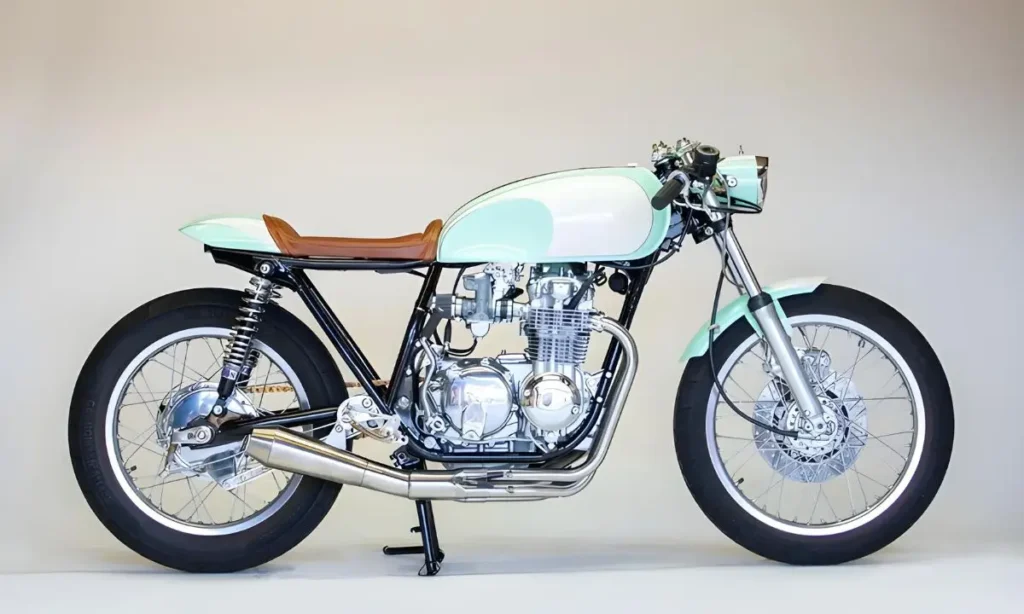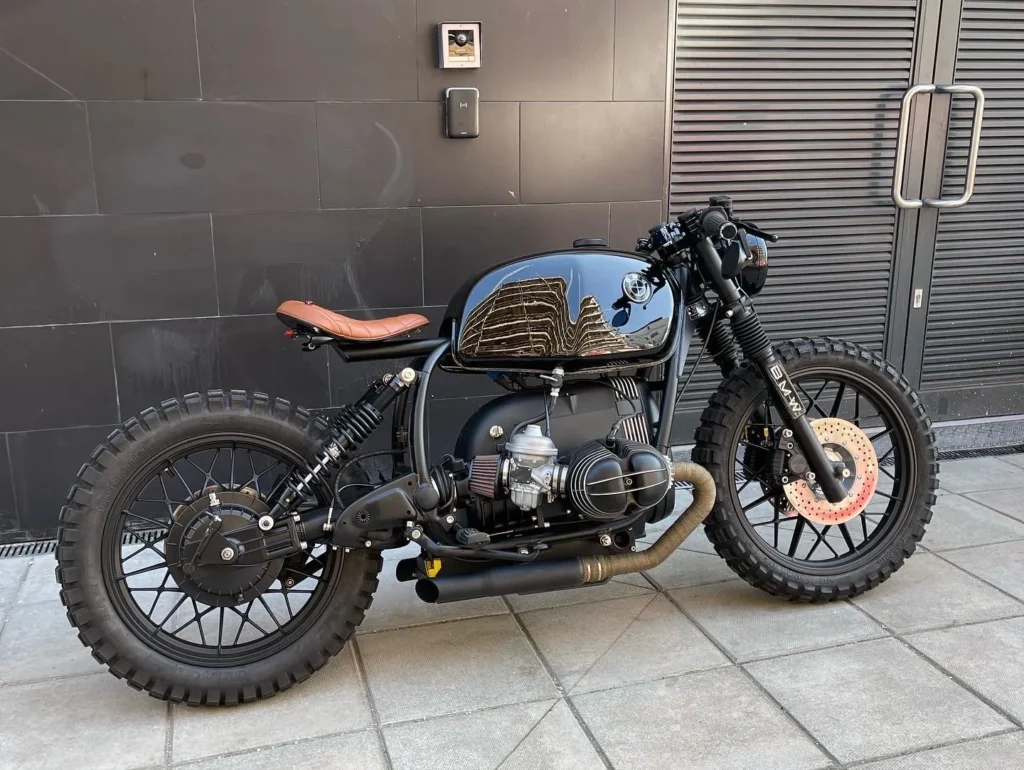Table of Contents
ToggleSo, you have a BMW K1100 cafe racer? Great choice! Whether you’re an experienced rider or just love cafe racers, it’s important to take good care of your BMW K1100. I understand how tricky it can be to maintain a vintage bike. It might feel hard at times, but don’t worry. I’m here to help you through it, step by step.
Taking care of a BMW K1100 cafe racer doesn’t have to be difficult. With the right tools, knowledge, and effort, you can keep your bike in great shape. Whether you’re riding through the city or cruising the highways, you’ll enjoy every moment. I’ll guide you through everything from basic maintenance to advanced care, so your bike always runs smoothly.
Understanding the BMW K1100 Cafe Racer’s Unique Features
Before we get into how to maintain the bike, let’s talk about what makes the BMW K1100 special. The K1100 is often called the “Flying Brick” because of its boxy engine. It is known for being strong and long-lasting. The 1092cc engine was a big deal when it came out. It has lots of power, making it good for commuting or long rides.
But even though it’s tough, the K1100 has its own quirks. For example, it weighs about 595 pounds. That means it’s not the easiest to handle, but it’s very steady on the road. With its weight, you need to take extra care of the suspension, brakes, and cooling system.
Also, the K1100 is bigger than most cafe racers. It’s heavier and bulkier. But if you love the mix of a vintage look with BMW’s engineering, it’s worth the work. So, let’s dive into how to keep this bike in top shape.
Essential Regular Maintenance Tasks
Taking care of your BMW K1100 cafe racer means regular maintenance. Skipping the basics will only cause bigger problems later. It’s always easier to stop an issue before it gets worse. Let’s go over the routine tasks you need to stay on top of.
Oil and Fluids Change
Start here. Regular oil changes are very important. For the K1100, I suggest changing the oil every 3,000 to 5,000 miles, depending on how hard you ride. Use high-quality engine oil—20w50 is a good choice because it handles heat well, which is important for air-cooled engines like the K1100. Keeping the engine lubricated helps reduce wear and makes sure it runs smoothly.
You should also check your brake fluid, coolant, and clutch fluid levels. Always use BMW-approved fluids or high-quality alternatives. For brake fluid, use DOT 4, and replace it once a year. Brake fluid can attract moisture over time, which may damage your braking system if ignored.
Brake System Maintenance
Let’s talk about taking care of your brakes. The K1100 has a strong brake system with Brembo calipers and dual discs in the front. But over time, the brake pads and discs will wear out. You should check the brake pads every 6,000 miles. If you hear squeaking or notice weaker braking, it’s time to change them.
Here’s a tip: if the brakes feel “spongy” after you change the fluid, make sure to bleed the brake lines properly. Trapped air can reduce braking power. If you like doing some work yourself, consider upgrading to braided steel brake lines for better response.
Tire Care and Replacement
When was the last time you checked your tires? It’s easy to forget, but they are one of the most important parts of your bike. BMW K1100s often come with Avon or Michelin tires from the factory. If you want that vintage cafe racer look, you can choose classic-style tires, but performance should still come first.
Check your tire pressure often—ideally before every ride. Low tire pressure can hurt your handling, which matters a lot on a heavy bike like the K1100. I keep my front tire at 32 PSI and the rear at 36 PSI. Also, watch for uneven wear. It could mean something is wrong with your alignment or suspension.
Keeping the Engine in Peak Condition
Your engine is the heart of your bike, and the K1100’s engine needs care. With a 1092cc engine that delivers around 100 horsepower, it’s got a lot of power. But with that power comes the need to maintain it properly.
Engine Overhaul Tips
First, keep the air filters clean. The K1100 engine needs good airflow to run well. A dirty air filter can hurt performance. I check the air filter every 3,000 miles. Cleaning or replacing it is easy and helps your bike run better. While you’re at it, check the throttle bodies for any dirt.
Second, look at the fuel injectors. BMW K-series bikes often use Bosch injectors, and they work well. But if your bike idles rough or the throttle feels off, the injectors might need cleaning or replacing. I think it’s a good idea to do this once a year.
Cooling System Maintenance
The K1100 tends to run hot, especially in city traffic. That’s why it’s important to keep the cooling system in good shape. The bike uses liquid cooling, but overheating can still happen. Always check the coolant level before long rides. If the bike has not been used for a while, flush the system and add new coolant.
Use a good, BMW-approved coolant. Also, check the radiator for blockages or leaks. If you often ride in hot weather, think about upgrading to a better oil cooler.
Electrical and Wiring Maintenance
Now, let’s talk about the electrical system. It’s something that many people overlook. If you own an older bike like the BMW K1100, you know the wiring can be a problem over time. The original wiring is good, but it can wear out. If you’ve added new things like LED lights or digital gauges, you need to be extra careful. Make sure to keep everything in good shape.
Rewiring the K1100 for Modern Components
Upgrading the electrical system might seem scary, but it’s one of the best things you can do for your K1100. A great upgrade to think about is the Motogadget M-unit. This part is a game-changer. It updates the bike’s electrical system. You can add things like keyless start, modern lights, and even Bluetooth control. It might sound fancy, but it makes taking care of the wiring much easier.
If you’re keeping the old wiring, remember the basics. Check the battery terminals and fuse box often for signs of rust. Many electrical problems start with small issues, like loose connections or moisture. If your lights are flickering or the bike won’t start, a quick check could find an easy fix.
Common Wiring Issues
One of the most common problems on older K1100s is bad wiring. These bikes are old, and while BMW built them well, wires from the ’90s can wear out. Many electrical issues come from bad grounds or broken connections.
Tip: Use a multimeter often to check for problems. This can help you find issues before they leave you stuck. It’s also smart to carry a small kit of electrical tools when riding. Trust me, it’s better to be safe than sorry when electrical issues show up.
If you see flickering lights or your bike stops suddenly, don’t worry. It’s often a grounding problem. Check the ground connections on the frame and engine. Fixing these small problems can make a big difference and keep your ride smooth.
BMW K1100 Maintenance Costs
Keeping your BMW K1100 cafe racer in good shape is important and can be satisfying. Here’s a simple guide on the costs you may face:
- Oil Changes: Expect to spend $30-$50 on high-quality oil and filters. Change the oil every 3,000 to 5,000 miles to keep your engine running well.
- Brake Pads and Fluid: Replacing brake pads costs $70-$150, depending on the brand and if you do it yourself or hire a shop. Brake fluid replacement costs about $20-$30, plus extra if you need a professional to bleed the brakes.
- Tires: A good set of tires costs $150-$250. You may need to replace them every 6,000 to 10,000 miles, depending on your riding style.
- Air Filters and Fuel Injectors: Air filters cost $20-$40. Cleaning or replacing fuel injectors costs $50-$100. Regular checks can help avoid more expensive repairs later.
- Cooling System Maintenance: Flushing and replacing coolant might cost $30-$50. If there are leaks or blockages, repairs could cost more.
- Electrical Repairs: Minor wiring fixes may cost about $50. If you upgrade parts or have major issues, costs could rise to $200 or more.
By keeping track of these costs and planning for regular maintenance, you can avoid surprise expenses and keep your BMW K1100 running smoothly.
Chassis, Suspension, and Fork Maintenance
Suspension is often ignored when maintaining a vintage cafe racer. But this is a big mistake. The BMW K1100 is a heavy bike. Without proper suspension care, your ride can go from smooth to rough very fast. Whether you use the stock setup or have upgraded forks, taking care of your suspension is key.
Fork and Suspension Tuning
If you’ve upgraded your K1100’s front forks, like swapping them for GSXR 1000 forks, you’ll get a smoother ride. Even stock suspension works well if you take care of it. Be sure to check your fork seals often. If you see any oil, it’s time to rebuild the forks.
I also suggest adjusting your suspension to fit your weight and riding style. Stock settings are okay, but adjusting preload and damping can make a big difference. You might need a special tool or a visit to a specialist, but it’s worth it.
Frame Maintenance and Modifications
Many K1100 cafe racers have custom frame work. Whether you’ve changed the subframe or kept the stock one, it’s important to check the frame often. Look for rust or cracks, especially near welds. If you’ve done custom work, make sure all changes are strong and safe.
If you haven’t upgraded your subframe yet, now might be a good time. A strong cafe racer frame not only looks great but also makes the bike handle better and feel more comfortable. Just be sure to cover any bare metal to stop rust.
Maintaining the Aesthetic and Cafe Racer Modifications
One of the best things about owning a BMW K1100 cafe racer is how good it looks. You’ve likely spent time making it perfect, whether it’s the custom seat, unique paint, or vintage lights. But keeping it looking great takes a bit more work.
Cleaning and Polishing
The easiest way to keep your cafe racer looking good is to clean it regularly. Dust, dirt, and bugs can make your bike look dull over time. I suggest using a soft cloth and a mild cleaner—nothing too strong, especially on custom paint. Also, remember to polish the metal parts like the exhaust pipes and handlebars. For chrome or stainless steel, I use a metal polish that protects against rust.
If you see rust on your frame or other metal parts, act fast. Rust can spread quickly and cause more damage. Use a wire brush to clean it off and apply a rust-proof paint or coating to protect it.
Upgrading for Style
Upgrading your K1100 for a cafe racer look isn’t just about speed. It’s also about style. Adding bar-end mirrors, a custom seat, or LED lights can make a big difference. Keeping these upgrades in good shape is part of the fun.
For example, if you’ve added vintage lights, check the wires often to make sure they work right.
If your seat is custom-made, like from leather or Alcantara, clean it often. Leather can dry and crack, so use a leather conditioner to keep it soft and lasting longer.
Common Problems and How to Fix Them
Every bike has its own issues, and the BMW K1100 is the same. It is usually reliable, but a few common problems can happen over time. I’ve dealt with some of these myself, and knowing how to fix them can save you trouble.
Common Issues with K1100 Engines
One common problem is overheating. The K1100 gets hot, especially in slow traffic. If your bike feels hotter than usual, check the cooling system first. Make sure the coolant is full, and there are no leaks in the radiator or hoses. You should also check the thermostat and water pump to see if they are working right.
Another issue is oil leaks. These can happen in the engine, transmission, or final drive. Look for oil spots where you park your bike. If you find a leak, trace it back to the source. Then, replace the needed gaskets or seals. It’s usually a small fix that can stop a bigger problem later on.
Electrical Gremlins
The electrical system can act up, especially if you’ve changed something. A common problem is the battery not charging right. This is often because the alternator or regulator is not working. Check the voltage from the alternator to see if it is charging the battery.
If you have power issues, check your ground connections. A bad ground can cause strange problems, like lights flickering or the bike stopping.
Recommended Tools and Parts
I like to do as much of my bike work as I can. It saves money and helps you know your bike better. To do this, you need the right tools. Here’s a short list of the basic tools you need to take care of a BMW K1100 cafe racer.
Must-Have Tools for DIY Maintenance
- Torque wrench – For making sure you tighten everything to the correct specifications.
- Oil filter wrench – Changing your oil regularly? You’ll need this.
- Multimeter – This is invaluable for tracking down electrical issues.
- Allen key set – Most bolts on the K1100 are Allen head, so having a full set is crucial.
- Brake bleeder kit – If you’re doing your own brake work, a bleeder kit will make your life much easier.
Where to Source Reliable Parts
When choosing parts, it’s best to pick good ones. Cheap parts may save you money now, but they cost more later. For BMW K1100 parts, I use OEM or trusted aftermarket suppliers. Websites like MaxBMW and Beemer Boneyard are great for OEM parts. If you want custom parts, try Motogadget or Cafe4Racer for high-quality choices.
Additional Resources for Enthusiasts
Owning a BMW K1100 cafe racer is about the bike and the community. There’s a big group of fans happy to share tips and advice. Whether you need help with a repair or want to show off your latest upgrade, these forums are a good place to start:
- BMW MOA (Motorcycle Owners of America) – A helpful resource for BMW riders.
- K-Bikes.com – A forum for K-series bikes, full of tips and advice.
- Cafe Racer Forum – A larger cafe racer group where you can meet other builders and fans.
Conclusion
Taking care of your BMW K1100 cafe racer doesn’t have to be hard. With a bit of effort, you can keep your bike in top shape. This will make sure it rides as good as it looks. From regular oil changes and brake checks to upgrading the electrical system and keeping the frame clean, caring for your K1100 is worth it.
By following these tips, you’ll make your bike last longer and enjoy a smoother, safer ride. So, grab your tools and get to work. Your cafe racer deserves it—and you’ll have fun doing it.
FAQs
What are the main maintenance tasks for a BMW K1100 cafe racer?
To keep your BMW K1100 cafe racer in good shape, you need to do a few key things. Change the oil regularly, check and replace brake pads, and keep an eye on tire pressure. Make sure the cooling system works well, clean or replace air filters, and check the electrical system and suspension. These steps will help your bike run smoothly.
How often should I change the oil in my BMW K1100 cafe racer?
You should change the oil in your BMW K1100 cafe racer every 3,000 to 5,000 miles. Use high-quality 20w50 engine oil. This helps the engine handle heat and stay lubricated, which keeps it running well.
What are common electrical issues with the BMW K1100, and how can I fix them?
Common electrical issues include battery charging problems, flickering lights, and bad grounding. To fix these, check the battery terminals, inspect the alternator and regulator, and clean the ground connections. Upgrading to modern parts, like the Motogadget M-unit, can also help with electrical issues.
How can I improve my BMW K1100 cafe racer’s handling?
To improve handling, focus on the suspension. Check and fix fork seals if needed. Adjust the suspension settings to suit your weight and riding style. Make sure your tires are properly inflated and the chassis is well-maintained. These steps will help your bike handle better.
What are the costs for maintaining a BMW K1100 cafe racer?
Here are some typical costs:
Oil Changes: $30-$50.
Brake Pads and Fluid: $70-$150 for pads; $20-$30 for fluid.
Tires: $150-$250 per set.
Air Filters and Fuel Injectors: $20-$40 for filters; $50-$100 for injectors.
Cooling System Maintenance: $30-$50.
Electrical Repairs: $50 for minor fixes; $200+ for major repairs or upgrades.
Regular maintenance helps avoid surprise costs and keeps your bike in good condition.



